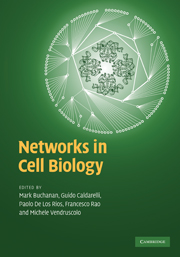Book contents
- Frontmatter
- Contents
- List of contributors
- Introduction
- 1 Network views of the cell
- 2 Transcriptional regulatory networks
- 3 Transcription factors and gene regulatory networks
- 4 Experimental methods for protein interaction identification
- 5 Modeling protein interaction networks
- 6 Dynamics and evolution of metabolic networks
- 7 Hierarchical modularity in biological networks: the case of metabolic networks
- 8 Signalling networks
- Appendix A Complex networks: from local to global properties
- Appendix B Modelling the local structure of networks
- Appendix C Higher-order topological properties
- Appendix D Elementary mathematical concepts
- References
- Index
8 - Signalling networks
Published online by Cambridge University Press: 05 June 2012
- Frontmatter
- Contents
- List of contributors
- Introduction
- 1 Network views of the cell
- 2 Transcriptional regulatory networks
- 3 Transcription factors and gene regulatory networks
- 4 Experimental methods for protein interaction identification
- 5 Modeling protein interaction networks
- 6 Dynamics and evolution of metabolic networks
- 7 Hierarchical modularity in biological networks: the case of metabolic networks
- 8 Signalling networks
- Appendix A Complex networks: from local to global properties
- Appendix B Modelling the local structure of networks
- Appendix C Higher-order topological properties
- Appendix D Elementary mathematical concepts
- References
- Index
Summary
Introduction
Biological systems react to changes in the surrounding environment by adjustment of their properties and functioning. The simplest cases include the capacity of prokaryotes to change the expression levels of specific proteins, as well as their distance from the source of chemical substances. In eukaryotes and multi-cellular organisms, the property of monitoring the environmental conditions and responding to their transformations has attained levels of particular complexity, through the development and evolution of means of supporting the communication among separate districts within the same organism, and among different organisms as well. Two general types of communication are classically described in biological systems. Neuronal communication is the first of them, comprising the networks of fibres connecting the different parts of organisms. Another kind of communication in living systems takes place by chemical signals that are produced and released from some cell sources, diffuse in the environment surrounding the emitting system, being it a liquid or air, and eventually reach the target cells. Two major features distinguish neuronal and chemical signalling: the means supporting the signals and the distance between the source and the target of signals. In neuronal communication the signal is mechanically supported by individual nerve fibres and travels distances related to the size of the organism about, being up to 10 m. The distance between the source of the chemical signal and its target, in contrast, is not limited by the existence of a physical wire connecting the emitting source and its target.
- Type
- Chapter
- Information
- Networks in Cell Biology , pp. 135 - 169Publisher: Cambridge University PressPrint publication year: 2010



